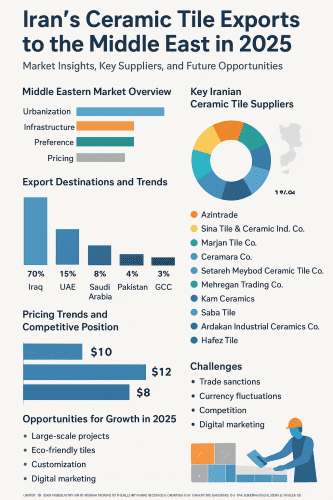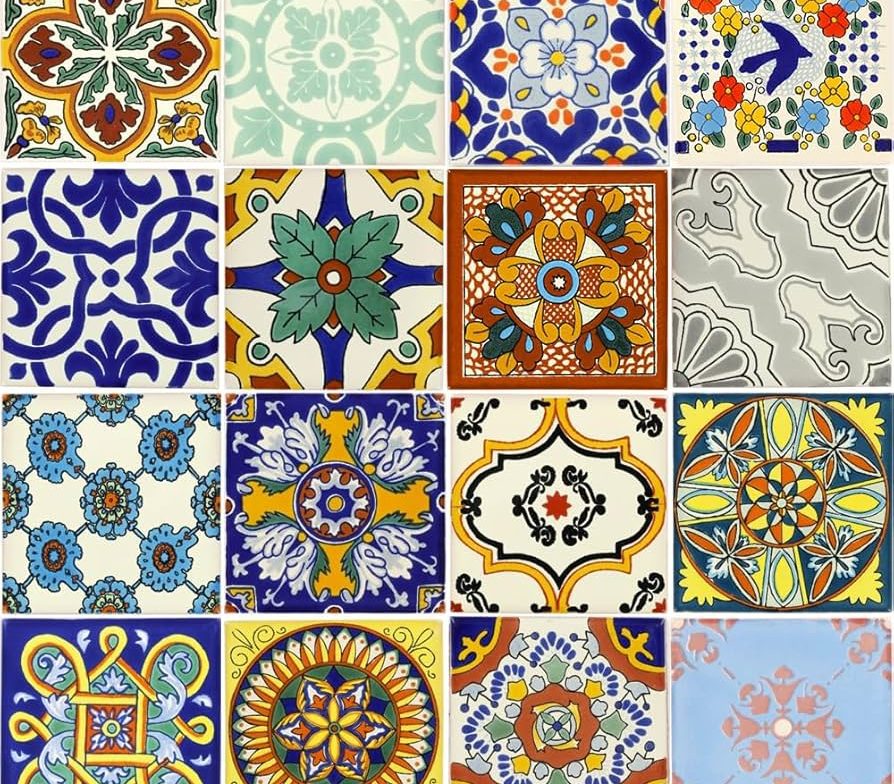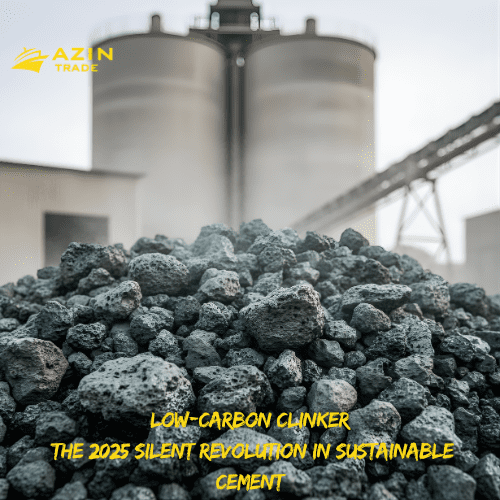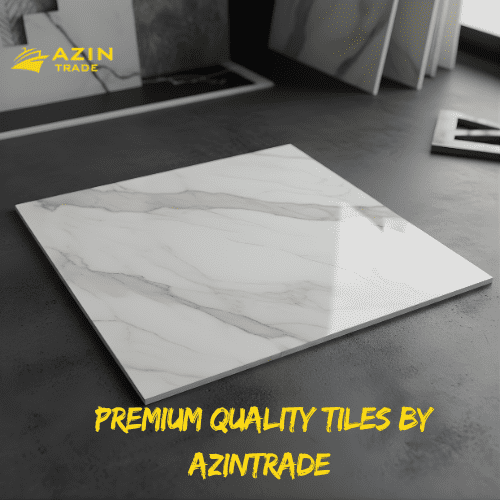Ceramic Tiles Exports to the Middle East in 2025
Iran has long been recognized for its ceramic tiles industry, blending traditional artistry with modern manufacturing technology. In 2025, Iran is projected to produce approximately 700 million square meters of ceramic tiles, a substantial portion of which is exported to the Middle East. Countries such as Iraq, UAE, Saudi Arabia, Pakistan, Afghanistan, and GCC nations are major buyers, driven by urbanization, infrastructure development, and demand for cost-effective, high-quality building materials.
This article provides a comprehensive analysis of Iran’s ceramic tiles exports, including market dynamics, top suppliers, pricing trends, challenges, and opportunities. It also highlights ten leading Iranian companies supplying ceramic tiles to the region, including Azintrade.
1. Middle Eastern Ceramic Tiles Market Overview
1.1 Market Demand for Ceramic Tiles
The Middle East is a region with rapid urban growth and extensive construction projects, making it a lucrative market for ceramic tiles. High-rise buildings, residential complexes, commercial offices, shopping malls, and luxury hotels all contribute to steady demand.
-
Population Growth: Countries like Iraq, UAE, and Saudi Arabia continue to experience significant population growth, increasing the need for residential construction.
-
Government Initiatives: Urban development plans and large infrastructure projects create consistent requirements for building materials, especially ceramic tiles.
-
Quality and Design Preferences: Buyers seek tiles that are both durable and visually appealing, with modern designs, traditional motifs, or luxury finishes depending on the project type.
1.2 Why Middle Eastern Buyers Choose Iranian Ceramic Tiles
-
High Quality: Iranian tiles are known for durability and long-lasting quality.
-
Diverse Designs: A wide range of patterns, colors, and finishes suit various architectural styles.
-
Competitive Pricing: Compared to Turkey and China, Iranian tiles provide better price-to-quality ratio.
-
Strategic Location: Iran’s proximity to Middle Eastern countries reduces shipping time and logistics costs.
-
Cultural and Trade Relations: Strong historical and commercial ties with neighboring countries enhance trust and reliability.
2. Key Iranian Ceramic Tiles Suppliers
Iran has a strong network of companies trusted by Middle Eastern buyers. Ten leading suppliers include:
-
Azintrade – Wide range of ceramic tiles and building materials; efficient export processes.
-
Sina Tile & Ceramic Ind. Co. – Modern designs suitable for residential and commercial projects.
-
Marjan Tile Co. – Innovative patterns with high production standards.
-
Ceramara Co. – Diverse tiles for multiple applications.
-
Setareh Meybod Ceramic Tile Co. – Eco-friendly and customized solutions.
-
Mehregan Trading Co. – Timely deliveries and excellent customer service.
-
Kam Ceramics – Luxury tiles with unique designs.
-
Saba Tile – Focus on durability and aesthetic appeal.
-
Ardakan Industrial Ceramics Co. – Advanced manufacturing and innovative designs.
-
Hafez Tile – Traditional and modern designs ensuring consistent quality.
3. Export Destinations and Ceramic Tiles Trends
3.1 Iraq
Iraq is the largest importer of Iranian ceramic tiles, accounting for ~70% of exports. Reconstruction and urban expansion drive high demand.
3.2 United Arab Emirates (UAE)
The UAE serves as a hub for luxury projects. Iranian tiles are popular for quality, design variety, and competitive pricing.
3.3 Saudi Arabia
Saudi Arabia’s Vision 2030 projects create opportunities for Iranian tiles in residential complexes, hotels, malls, and offices.
3.4 Pakistan and Afghanistan
Growing construction sectors prefer affordable, durable, and locally acceptable tiles.
3.5 GCC Countries (Qatar, Kuwait, Bahrain)
High-end projects and infrastructure expansion increase demand for quality ceramic tiles, which Iranian suppliers can efficiently provide.

4. Ceramic Tiles Pricing Trends and Competitive Position
4.1 Factors Affecting Tile Pricing
-
Tile dimensions and thickness
-
Glaze type and finish
-
Design complexity
-
Order volume and shipping costs
4.2 Competitive Position
Iranian tiles offer a cost-effective alternative to Turkish and Chinese products, appealing to buyers seeking high-quality materials at competitive prices.
5. Challenges for Iranian Ceramic Tiles Exporters
-
Trade Sanctions – Affect payments and logistics.
-
Currency Fluctuations – Impact pricing and profitability.
-
Competition – Turkish and Chinese tiles dominate some markets.
-
Logistics and Infrastructure – Timely delivery depends on efficient supply chains.
-
Customs and Regulations – Import procedures may delay shipments.
Mitigation Strategies: Long-term partnerships, digital B2B platforms, and market diversification.
6. Opportunities for Growth in 2025
-
Large-scale Infrastructure Projects: Gulf countries invest in urban expansion and mega complexes.
-
Eco-friendly Tiles: Rising demand for sustainable ceramic tiles.
-
Customization: Unique designs for luxury projects.
-
Digital Marketing: Online B2B platforms expand reach.
-
Strategic Alliances: Partnerships with local distributors improve logistics and market penetration.
7. Human-Centered Perspective
Middle Eastern buyers value reliability, quality, and design diversity. Iranian suppliers provide personalized customer service, help with customs procedures, and ensure timely delivery, strengthening long-term relationships.
8. Future Outlook for 2025 and Beyond
-
Continued urbanization and construction projects
-
Increasing demand for premium and customized tiles
-
Strengthened trade networks and distributor partnerships
-
Adoption of digital tools for order management and marketing
By focusing on innovation, sustainability, and customer-centric services, Iranian suppliers can consolidate their position as trusted providers of tiles.
Conclusion
Iran’s tiles industry is entering a strategic growth phase in 2025. With diverse products, a network of leading suppliers including Azintrade, and a strong presence in key Middle Eastern markets, the country is well-positioned to expand exports. Quality, competitive pricing, innovative designs, and personalized service ensure Iranian tiles remain a preferred choice.




